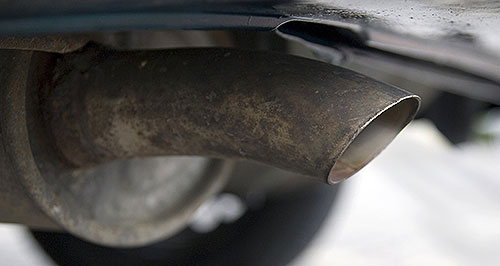News - Market Insight - Market Insight 2015Market Insight: New-car emissions down but rate slowsFacing facts: Australia’s average CO2 tailpipe emissions intensity is continuing to fall, but the car industry is still not within cooee of the EU – or even the worst-performing EU member state, Estonia. Tailpipe emissions in Australia fall, but 2.3 per cent drop the slowest since 200920 Apr 2015 By TERRY MARTIN THE rate at which carbon dioxide emissions from new passenger cars and light commercial vehicles sold in Australia are falling, with CO2 emissions down to 188 grams per kilometre but remaining well behind other regions such as Europe. Figures released by the National Transport Commission (NTC) last weekend show that average CO2 tailpipe emissions for passenger cars fell 2.6 per cent to 177g/km, while LCVs improved only 0.5 per cent to 235g/km. The NTC has used the results to highlight the ongoing improvement achieved over the past decade – down 22 per cent for the period – however the rate is the slowest annual improvement in five years and Australia’s position remains in stark contrast to Europe. Provisional figures released last week by the European Environment Agency show that the average emissions for a new passenger car sold in 2014 across the EU was 123g/km – significantly below the 130g/km target set for 2015, and well on the way to achieving the 95g/km required by 2021. These figures encompass all 28 EU member states, across which 12.5 million new cars were registered last year – the first overall improvement in sales since 2007, just before the global financial crisis hit. Look further into individual markets and the Netherlands again emerged as the country which buys the most efficient cars (107g/km), followed by Greece (108g/km) and Portugal (109g/km), while even those with the least-efficient cars – Estonia (141g/km), Latvia (140g/km) and Bulgaria (136g/km) – were well underneath Australia’s 177g/km passenger car average. The reasons behind Australia’s higher result are many and varied, including buyer preference for SUVs, which are higher-polluting than passenger cars, and the generally low take-up rate of ‘green’ vehicles, which is a segment that rose 0.6 per cent in sales terms last year but still only represents 2.8 per cent of the total market. Lower fuel prices and improved technology of conventional internal combustion engines are among the factors discouraging the purchase of electrified vehicles, compounded by a lack of government policy and regulations for ultra-low-emissions vehicles. Echoing comments he made this time last year, NTC chief executive Paul Retter said: “Ten years ago there were only three low-emission car models available to Australians. Today, our car buyers can choose from 59 models that emit less than 120 grams of carbon dioxide for every kilometre they travel. “Of course, not every Australian is choosing a low-emissions car. If every new car buyer chose the lowest emissions car available our national average emissions would improve by 50 per cent (to 95g/km).” Until Australia’s car manufacturing industry closes in 2017, government purchases will also still be skewed towards locally built cars, which last year had an average CO2 emissions intensity of 210g/km – a figure that has not improved since 2012 and which last year actually brought increases with the latest Ford Falcon and Holden’s Caprice and Cruze. Government buyers last year purchased vehicles with the highest average CO2 emissions (207g/km), with business buyers a little greener in their decisions (193g/km) but still well behind private buyers on 182g/km. Among the top 15 brands by sales volume, BMW again had the lowest corporate average emissions intensity (151g/km), while Jeep remained the highest at 222g/km. Significantly, prestige brands are leading the way with Audi (155g/km), Volkswagen (159g/km) and Mercedes-Benz (160g/km) joining BMW at the top of the table, with Mazda the best of the mainstream brands at 164g/km and the biggest mover across the entire industry last year with a massive 10.7 per cent reduction over 2013. Honda, which is close behind Mazda at 168g/km, was the second-biggest improver last year with a 4.6 per cent reduction, while big-name brands Holden and Hyundai went backwards with increases of 1.0 and 0.4 per cent respectively. Despite selling four hybrid model lines and achieving a 1.2 per cent reduction in CO2 intensities last year, market leader Toyota could only manage 11th place – with 201g/km – on the list of top-15 brands (by sales) in terms of CO2 output across its range. This still proved to be better than Nissan (202g/km), Ford (205g/km) and Holden (214g/km), which were with Jeep at the bottom of the table.  Read more2nd of June 2014  Car buyer habits keep nation’s CO2 levels highEnvironment takes back seat as Aussie new-car buyers stick to bigger, thirstier cars25th of May 2014  Market Insight: Brands battle for CO2 honoursMitsubishi, VW improve most amid mixed results in CO2 averages for local car sector25th of May 2014  New-car emissions continue to fallAverage CO2 for light vehicles in Australia down to 192g/km, but more could be done14th of March 2013  New cars clean up their actAustralia’s average exhaust pipe emissions falls, but we still lag Europe14th of March 2012  New vehicle emissions fall – but not enough, says NTCTransport Commission says Oz buyers need to make greener purchasing decisions6th of February 2012  Vehicle CO2 emissions drop 2.8 per centLatest good news on carbon emissions might pave the way for stiffer car standards |
Click to shareMarket Insight articlesResearch Market Insight Motor industry news |

















Facebook Twitter Instagram